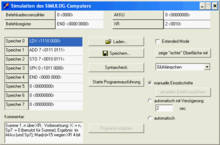Simulog
SIMULOG (from simulator and logic ) is the name for a teaching system for teaching purposes from the company LD Didactic GmbH , with which elementary logic circuits can be set up using a simple plug-in system.
technology
There is a base plate with slots and a number of modules with basic elements of logic circuits ( flip-flops , gates , half adders , full adders , clocks, etc.).
All required modules are placed on the base plate, from which they receive their supply voltage.


Each module contains sockets for the important inputs and outputs and can be connected to other modules with the aid of cables by simply plugging them in. This allows higher logic circuits, such as shift registers or binary counters , to entire arithmetic units to be built from flip-flops and other basic elements . The outputs of the modules are indicated by lamps or today with light-emitting diodes .
history
The history of the Simulog begins in the late 1960s. In the first few years, the building blocks were developed in the training laboratory of the Badische Anilin- und Soda-Fabrik ( BASF ) by Dr .E. Merkel developed. T. Ziegler was also significantly involved. At that time, the Simulog system was mainly used by committed physics and mathematics teachers, e.g. B. at the Carl-Bosch-Gymnasium in Ludwigshafen , to which BASF made the building blocks available as a (permanent) loan.
Since ICs and LEDs were not yet available at that time, logic gates, flip-flops, clock generators, etc. were composed of discrete circuit technology (from individual diodes, transistors, etc.), the switching status was represented by light bulbs. The construction was carried out in sandwich construction: a lower board contained the electronics and the two plugs for the power supply, about 2 cm above it was a cover plate with the respective circuit symbol and the sockets for the connection to other circuits.
In the early 1970s, the system was taken over by the Leybold-Heraeus company and made available in modular form as teaching material for schools. From a technical point of view, the individual building blocks initially remained unchanged, only the sandwich construction was replaced by a fully enclosing plastic housing. The accompanying workbook contained a comprehensive 600-page introduction to Boolean algebra and the structure of combinatorial and sequential logic circuits through to simple computer arithmetic units.
The teaching system was then continuously expanded with new modules (microprocessor, PLC, traffic lights, etc.) and is still used today for teaching purposes. Today the modules usually contain the corresponding integrated circuits in TTL technology.
Web links
Individual evidence
- ↑ T. Ziegler: The SIMULOG, a student exercise and demonstration device for the simulation of logic functions, essay together with E. Merkel, Ludwigshafen a. Rh., In: Die Leybold-Welle, issue 29 1967
- ↑ E. Merkel: SIMULOG - workbook: Boolean algebra, propositional logic, computers and cybernetics in over 200 demonstration and student experiments with the SIMULOG teaching device . LEYBOLD-HERAEUS, 1970 (Retrieved February 28, 2013).
